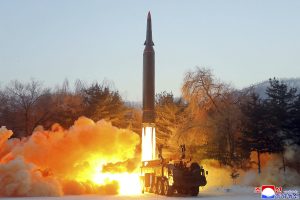North Korea fired an “apparent” hypersonic missile into the waters off its east coast from Jagang Province at 7:27 a.m. Korea Standard Time on Tuesday, according to South Korea’s Joint Chiefs of Staff (JCS). Tuesday’s launch came six days after North Korea fired its second hypersonic missile on January 5. Tuesday’s missile flew more than 700 kilometers at a max speed of Mach 10 and reached a top altitude of about 60 km, JCS said.
The North Korean missile launched last week, by comparison, appeared to fly below 700 km at a max speed of Mach 6 and top altitude of below 50 km, according to Seoul’s Defense Ministry.
The JCS announced the performance of the North’s missile launch approximately five hours after it detected it, implying today’s missile was far more threatening to the security of South Korea. It took two days for the JCS to publicly announce the capability of the North Korean missile that was launched on January 5.
Despite the improved missile capability of Tuesday’s “apparent” hypersonic missile, JCS did not name it as “a hypersonic missile.” Even the improved performance seen on Tuesday was not enough to recognize the North’s claim that it has successfully tested two hypersonic missiles in less than a week.
The missile launched on Tuesday was launched from the same place where North Korea conducted hypersonic missile tests last week and in September, an indication that this missile could be the new, advanced type of hypersonic missile or a most developed variant of what the North test-fired last week.
On Friday, South Korea downplayed the capability of the North’s second hypersonic missile by saying that Pyongyang has “exaggerated” its performance. Judging by the performance of the North Korean missile launched on Tuesday, as detailed by the JCS, the latest missile test could be meant to directly confront the South’s skepticism and prove that North Korea has successfully developed a hypersonic missile with advanced technologies.
Seoul’s National Security Council (NSC) expressed “strong regret” over the North’s missile launch, sending a more powerful message compared with the one it delivered after Pyongyang’s second hypersonic missile launch on January 5.
Experts predicted that North Korea will keep testing missiles for a while as part of its military drills and celebration of upcoming big events in February and April – the birthdays of previous leaders Kim Jong Il and Kim Il Sung, current North Korean leader Kim Jong Un’s father and grandfather, respectively. North Korea’s state media did not report any news on Kim’s birthday on January 8. Experts say that the North will likely designate his birthday as a holiday when he turns 40 in 2024, considering how North Korea deified Kim Jong Il on his 40th birthday in 1982 and 50th birthday in 1992.
U.S. Ambassador to the United Nations Linda Thomas Greenfield condemned North Korea’s January 5 missile launch and urged Pyongyang to “choose dialogue and peace over its unlawful and threatening weapons program” in a statement issued on behalf of Albania, France, Ireland, Japan, the United Kingdom, and the United States. The joint statement from six U.N. member states was released approximately two hours before North Korea tested another “apparent” hypersonic missile.
Cheong Seong-chang, the director of the Center for North Korean Studies at Sejong Institute in South Korea, told The Diplomat that North Korea’s leadership might have been outraged by the South Korean Defense Ministry’s assessment that the North’s missile test last week was an exaggerated “general ballistic missile,” not a hypersonic missile. “There is a possibility that North Korea would excessively conduct missile tests to prove incontrovertibly its ability to develop hypersonic missiles,” Cheong said.
However, Cheong added that the North’s hypersonic missile development will not bring any changes in the strategic balance between the South Korea-U.S. alliance and North Korea. Whatever Pyongyang’s missile capabilities, it knows that attacking South Korea with nuclear weapons would mean the North’s complete destruction.

































